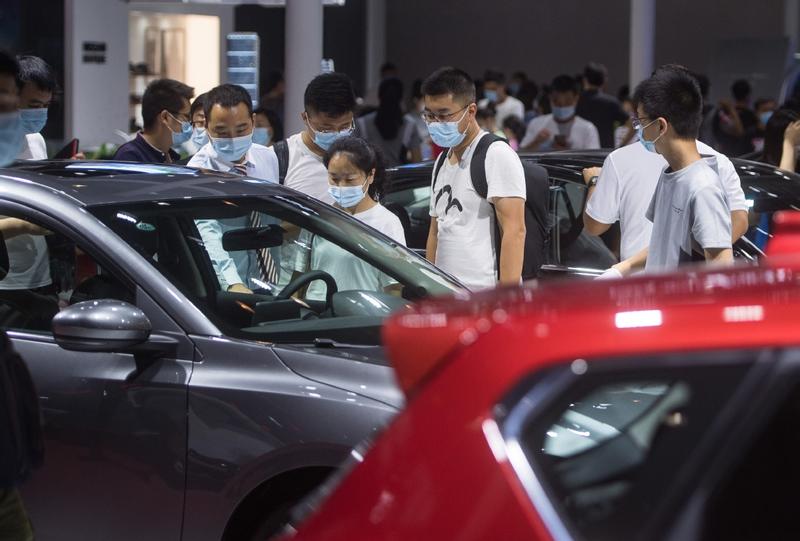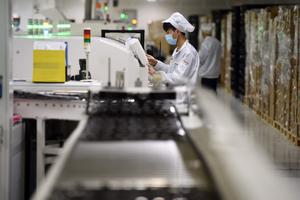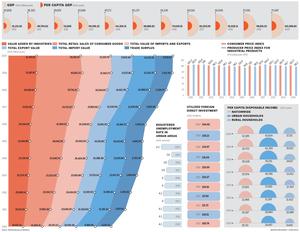The two sessions will deliberate on the plan for the next five years, but the cornerstone of growth is already in place
 People visit an international auto show held in Beijing in August. (XIAO YIJIU / XINHUA)
People visit an international auto show held in Beijing in August. (XIAO YIJIU / XINHUA)
Editor's Note: During this year's two sessions-the annual meetings of the National People's Congress and the National Committee of the Chinese People's Political Consultative Conference-China Daily will publish a series of stories focusing on the achievements the country made in various fields during the 13th Five-Year Plan (2016-20). They show how the country met its development goals in different fields in the face of numerous challenges.
While China focuses on the two sessions, the country's most important policymaking platform, other countries are looking at how the world's second-largest economy plans to overcome mounting challenges and maintain sustainable growth.
The COVID-19 pandemic has plunged the global economy into deep recession with rising trade protectionism, which could hinder external demand for Chinese products. Lingering tensions with the United States have added another layer of uncertainty.
Domestically, China's aging population could mean shrinking savings and higher labor costs in the future. The room for stimulating old sectors of the economy such as real estate and transportation infrastructure has narrowed, while growth of new areas is not developed enough to fully replace them.
The annual meetings of the National People's Congress, the top legislature, and the National Committee of the Chinese People's Political Consultative Conference, the top political advisory body, will come out with China's vision to tackle the challenges in the form of the 14th Five-Year Plan (2021-25). The plan will be the blueprint for China's social and economic development for the next five years and start the country's journey to fully build a modern socialist country.
 Employees perform tests at an LCFC(Hefei) Electronics Technology Co Ltd unit in Hefei, Anhui province. The factory serves as Lenovo's largest PC manufacturing base in China. (PHOTO / XINHUA)
Employees perform tests at an LCFC(Hefei) Electronics Technology Co Ltd unit in Hefei, Anhui province. The factory serves as Lenovo's largest PC manufacturing base in China. (PHOTO / XINHUA)
Two paths
While the plan is yet to be finalized, experts expect that the dual-circulation strategy will be its centerpiece and propel China to navigate future economic headwinds and achieve sustainable, high-quality growth.
Under the strategy, the domestic market is the mainstay of the economy, while domestic and international markets support each other.
After China put forward the dual-circulation development idea in May, officials at different levels of government stressed the importance of building the new paradigm.
Li Lin, chief economist at Beijing-based fintech company CreditEase, said the new strategy is expected to be the country's most important policy direction after the supply-side structural reform drive and guide China's development for the next five years.
The strategy focuses on fully utilizing domestic resources as opening up of the economy continues. The previous development model featured heavy reliance on external demand and production factors, especially natural resources and high-end technology, Li said.
At a symposium with entrepreneurs in July, President Xi Jinping explained the reasoning behind the new strategy. In the face of an external environment characterized by rising protectionism, a global economic downturn and a shrinking international market, China must give full play to the advantages of its huge domestic market to boost its economy and the global recovery, Xi said.
Efforts should be made to elevate the modernization of industrial and supply chains, promote scientific and technological innovation, and speed up breakthroughs in core technologies, Xi said.
Vice-Premier Liu He wrote in an article published in People's Daily in November that apart from being a strategic decision to respond to changes in the international arena, dual circulation addresses domestic economic problems, such as bottlenecks in the supply chain and mismatches between supply and demand.
Liu Wei, president of Renmin University of China, said the dual-circulation development strategy will not only deal with the current risks and challenges, but also ensure sustainable and high-quality economic growth.
Through supply-side reform measures, domestic demand will expand and drive a more effective supply of goods, Liu said.
The dual-circulation strategy is backed by a comprehensive supply system and a large, fast-growing domestic market, experts said.
China's value-added industrial output reached 31.3 trillion yuan (US$4.8 trillion) last year, making the country the largest manufacturing power in the world for 11 consecutive years, the Ministry of Industry and Information Technology said on Monday.

Innovation needed
According to the National Bureau of Statistics, China has more than 400 million middle-income residents and eradicated absolute poverty last year. Annual per capita GDP topped US$10,000 for the second year in a row last year.
But Liu said more reforms are needed to build a new development pattern, especially in spurring innovation in key technologies, industries and products. "Without innovation and breakthroughs," he said, there will be "a bubble-like cycle without real effects".
Business leaders have seen more development opportunities as the nation steps up reforms to build a stronger domestic market.
Saravoot Yoovidhya, CEO of Thai beverage company TCP Group, said that its business will benefit from the new strategy, as it is expected to stimulate China's huge consumer base to spend even more.
"With Chinese consumers demanding healthier, higher-quality, and more premium products, TCP is dedicated to fulfilling those evolving needs by continuing to provide our increasingly nutrition-conscious customers with exciting new product offerings," Yoovidhya said.
The new strategy will also help the country mitigate the effects of a more challenging external environment while further accelerating balanced, sustainable and inclusive growth, he added.
Lily Ma, managing director of Nutanix's China business said the country's rapid digital transformation has brought the US cloud computing software company more growth opportunities.
The company is excited to see that China is enhancing and upgrading national information technology infrastructure and will spend more to develop business in the country, Ma said.
Ouyang Shijia contributed to this story.
Contact the writers at zhoulanxv@chinadaily.com.cn


